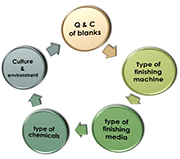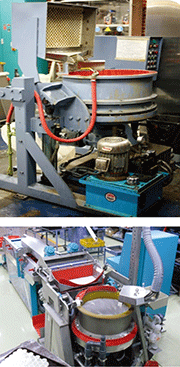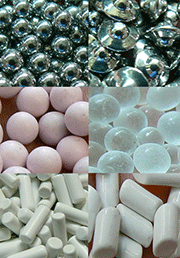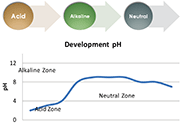E-Archive
Good Vibrations
in Vol. 17 - November Issue - Year 2016
First Cooperation Between State-owned Mints To Achieve An "Optimum Burnishing Process" For Silver Blanks

Testing elements

Equipment

Media

Appropriate cycle in using chemicals
The idea to cooperate internationally across competition borders was born at a Mint Directors Conference in 2014 in Mexico...
Background is the growing collectors demand worldwide on collector coins and medals in proof quality - as well as the demand on Silver Bullion for investors.
State Mints from the UK, South Africa, China and Mexico were part of the working group; the company Spaleck was invited as an observer and consultant to guide and coordinate the cooperation period.
The surface finishing of blanks in general is carried out to prepare the blanks prior to striking: remove oxides, dirt or marks from previous process steps and achieve a homogeneous surface condition - possibly with a specified "orange peel" for best striking behavior.
All parties had offered "open doors" for the team members to look at exciting processes for comparison and to establish the best possible finishing process:
The cooperating team has spent one week in each Mint to carry out a wide range of tests starting from "0":
It was understood that it was essential to put down a priority on the things to be tested, and look at the influencing factors of a burnishing process, like:
Quality and condition of incoming material of blanks, type of surface finishing machine, type of finishing media, type of chemicals.
It did not take long to recognize that there were two more very important aspects: ...the environment aspect, and maybe the most important one was the "culture of operators" and how they carry out their work (is "worth 10 pages" within this article).
The team week in South Africa has confirmed that within the comparison of drum finishing, vibratory finishing and centrifugal finishing, centrifugal finishing was the way to go.
The centrifugal finishing process offers, due to its characteristics, the most flexible process in the shortest times and repeatable finishing results.
The treatment program should be carried out automatically; possibly, all chemicals used should be monitored while they are introduced into the process. The centrifugal finishing system should be designed to allow a proper hexagonal media movement during the treatment time. The working tub should be designed to allow an intensive movement of media and blanks as well as a smooth operation.
It is essential to allow the process to consist of multiple process steps in which the water flow, usage of different chemicals and rotor speed are individually adjustable...
The team week had long working days and included nice South African wine at "days' end".
The week in Mexico offered to continue the test and the findings from South Africa...
Two centrifugal systems from different manufacturers were available to concentrate on the "choice of media"...
Plastic media, cylindrical porcelain media, ceramic media, glass balls and stainless steel media was tested...
Soon the stainless steel media was in "pool position" - it had offered the widest range of possibilities. Not only the process was the cleanest one and easy to repeat - it also had impacts on the hardness of the blank after the treatment. A micron layer of the blanks had changed the hardness. At that stage, it was recognized, but the influence of the hardness change during striking was not looked at...
Stainless steel was chosen as the media to be used, yet the shape and size had to be specified.
Small 2mm balls will create a bright and shiny surface, big media will remove little dents or damages from the blanks surface, although it would not be able to mechanically work properly in the rim area.
A media mix of medium-sized balls and satellites are an excellent solution as finishing media for a wide range of different blank types. There are big differences within the media quality and grade as well. The best results were found by using stainless steel media with "SHD" performance.
The "one tequila" at night for the team kept the team spirit quite high during the week.
Chemicals... testing week in China. When the communication and translating issues were solved - the testing went as per protocol, very disciplined and very well organized...
Using cheap chemicals like sulfuric acid within the process or sulfuric acid-based products have shown "ok results"; not taking into account the rapid wear of the stainless steel media, the wear rate of the equipment, and the environmental hurdles like cleaning the waste water produced within the surface finishing process.
The alternative recommendations for the pickling process were developed specifically to treat gold, silver and copper-based alloys. The triple salt-based products attacked neither the media nor the polyurethane lining of the centrifugal finishing machine!
The acid step for pickling turned into a polishing step when the alkaline polishing compound was added. The process did get a pattern that worked well in repeated batches. The rinse step at the end of the process was carried out with water - different water qualities have shown great influence on the final quality of the blanks as well!
The single "Mao Tai - test" during an early evening dinner has added on to the experience of the team! Sharing food at a round table is the nicest way to have dinner!
The drying method of silver blanks had already been developed some years ago!
The textile-drying method - it replaced corncob drying and recently also the hot-air drying method!
The Mint in the UK had trusted this drying method for years ago for their silver production and have adapted the same technology now for their circulation blank production! The big throughputs needed to be confirmed!
Drying silver blanks for the bullion or collector market requires spotless drying!
The blanks can be collected straight after finishing and drying in boxes or even better cassettes to become a beautiful coin after striking.
The results of all the efforts made during the weeks of testing are worth the travelling!
Great savings in water and chemicals (between 30 and 60%)
The rejection rate of blanks has been reduced dramatically (from up to 25% down to 1,5-3%)
The productivity has been increased (35 to 100%)
Using dedicated chemicals instead of "cheap & basic" has a great influence in the wastewater treatment, technically and economically!
A great improvement of the die lifetime within the striking process
The results of the study were presented at specific conferences and a number of producers of silver blanks have adapted the process and the advantages - including the retrofitting or replacing of their existing machines!
Future developments will lean towards the recycling of chemicals as much as possible including the process water!
Good Vibrations
by Thomas Hogenkamp, Contributing Editor MFN and Sales Director, Spaleck Oberflächentechnik GmbH, Germany
Tel. + 49.2871.9500.14
E-mail: thomas@mfn.li



























